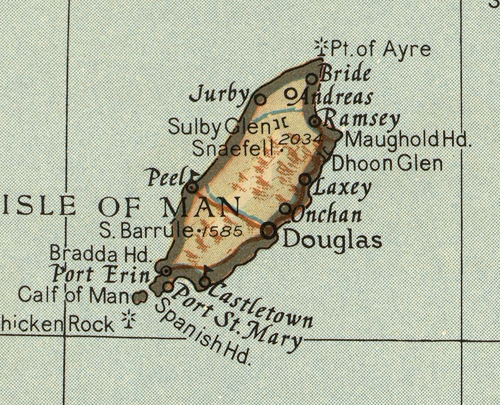The Isle of Man has many useful sources, and both online and traditional research techniques have their place in tracking down Manx forebears, writes Anne Corlett.
 Manx family history research is a relatively straightforward undertaking when compared with other regions. The island’s small population (fewer than 30,000 residents in the early 1800s) means that there are fewer records to search through. Furthermore, ancestors who left their home parish couldn’t go far, unless they left the island altogether. It’s worth being aware, though, that there was regular movement between the Isle of Man, Ireland and north-west England.
Manx family history research is a relatively straightforward undertaking when compared with other regions. The island’s small population (fewer than 30,000 residents in the early 1800s) means that there are fewer records to search through. Furthermore, ancestors who left their home parish couldn’t go far, unless they left the island altogether. It’s worth being aware, though, that there was regular movement between the Isle of Man, Ireland and north-west England.
Surviving records tend to be well-organised, with a large body of material available online. The IGI is described as ‘virtually complete’ for Mann (as the island is also known), and a useful section of the Manx Notebook website (tinyurl.com/p47s7ms) details the record coverage for each parish, complete with information about the various gaps. More information can be found at www.imuseum.im.
The Manx civil registration index is online at ManxBMD (www.manxbmd.com), and the census returns are available through Ancestry. Civil registration of marriages began in 1849 and registration of births and deaths started in 1878. While the birth and death registration was compulsory from its inception, registration of marriages only became compulsory in 1884.
Manx probate records are a rich source of information, with more women making wills here than in other regions. From 1885 the High Court of Justice dealt with Manx probate, and between 1874 and 1885 the relevant court was the Consistory Court of Sodor. Before 1874, probate was the jurisdiction of either the Consistory Court or the Archdeaconry Court of the Isle of Man, depending on the time of year. The Isle of Man Family History Society has an online wills index (www.iomfhs.im/wills/Index_A-Z.html) covering all Archdeaconry records from 1631 onwards, and Consistory court records from 1659 onwards. There is no index covering the Consistory Court records for the period 1600–1658. Later wills (from 1911 onwards) are held at either the island’s Public Record Office (www.gov.im/pro) or the Deeds and Probate Registry (www.gov.im/registries/general/Deeds_Probate/).
The Manx iMuseum website (www.imuseum.im) has digitised copies of Manx newspapers from 1792 to 1960. This is a subscription service, but you can search for free to see what is available before deciding whether to sign up.
For other online resources relating to the island it’s worth having a look at Genuki or at the links on websites such as the Manx Manorial Roll (tinyurl.com/paccsao). You may find that you can make good inroads into your Manx family tree from the comfort of your own front room, but the island is definitely worth a visit. The National Library and Archives reading room, located at the Manx Museum (tinyurl.com/o88ezop) is well-organised and has many potentially useful resources are not available online. If you’re not able to get there in person, the Manx Museum has an information sheet for family historians, including details of local genealogists who can be contacted with a view to carrying out paid research.
Tips for tracing Manx roots
- For many researchers the entry point to Manx ancestry comes from clues in the census returns relating to forebears from the north-west of England. Many families moved from the Isle of Man to Lancashire, Cheshire and Cumberland.
- The birth places and dates of family members can help to narrow down a timeframe during which the family left the island. For online searches use multiple search terms to improve your chances of finding the right family in an earlier Manx census.
- Use the ManxBMD site to track down children’s birth records. This data can be used to obtain birth certificates from the registry, and these should provide the mother’s maiden name. Citing the index reference will avoid extra search costs where the exact date of birth is unknown.
- If the parents’ marriage took place after 1884 then use ManxBMD. Before that date, search the parish records at the iMuseum site. For Catholic families, you may need to find a way to access the Catholic registers which are not online.
- Once you’ve exhausted the census and civil registration records, you should have an idea as to likely death dates of family members. You can now use an online index to find possible wills for your family members – the originals have been filmed by the LDS. The Isle of Man FHS library (www.iomfhs.im) holds burial registers for the island.
- Once you have a reasonable body of information, it’s time to start widening the search. Google ancestors’ names and locations, and check archive catalogues for details of likely records. At this point a trip to the island would be useful, or you might consider hiring a local researcher.
- An illegitimate ancestor is often the end of the research line, but those with illegitimate Manx forebears are in a better position than most. Manx midwives had a duty to establish a child’s paternity, with mothers put under pressure to name the father. Records of fornication proceedings often show that a child was ‘affiliated’ to the relevant father.
- The Manx Notebook (www.isle-of-man.com/manxnotebook/) has a wealth of useful information about specific topics of interest to genealogists, such as Manx inheritance laws, and non-conformism on the island. There are transcriptions of various documents, including wills and military sources, and the site also has links to other useful websites.
